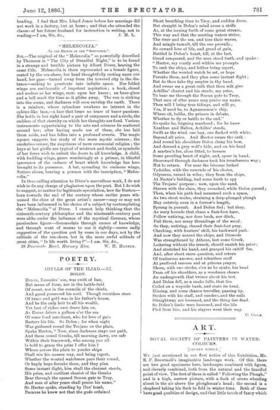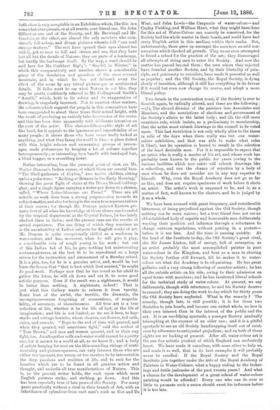ART.
ROYAL SOCIETY OF PAINTERS IN WATER- COLOURS. [SECOND NOTICE.] WE just mentioned in our first notice of this Exhibition, Mr. E. F. Brewtnall's imaginative landscape work. Of this, there are two good specimens here, landscapes combined with figure, and cleverly combined, both from the natural and the fanciful point of view. The first of these is called "Following the Plough," and is a high, narrow picture, with a flock of crows wheeling about in the air above the ploughman's head ; the second is a shepherd taking his flock to fold in winter-time. Both of these have good qualities of design, and that little touch of fancy which
both show is very acceptable in an Exhibition which, like this is a somewhat over-prosaic, or at all events, over-literal one. Sir John Gilbert at one end of the Society, and Mr. Brewtnall and Mr. Goodwin at the other, are almost the only members who occa- sionally fall asleep, and dream pictures wherein folk "can read strange matters?' The rest have opened their eyes almost too widely, got so near to hill and stream and sea, that they have lost all but the details of Nature; they see parts of a landscape, but hardly the landscape itself. By the way, a word should be said here for Mr. Cuthbert Righy's " Sea-fell in Winter," in which this comparatively new member shows a considerable grasp of the desolation and grandeur of the snow-covered mountain, and in which he has not frittered away the effect of the scene by any trivial picturesque or sentimental details. If folks want to see what Nature is not like, they may be pretty confidently referred to Mr. Collingwood. Smith's "Amalfi," which, both in its colour and its exaggeration of drawing, is singularly incorrect. Not to mention other matters, the columns which support the pergola in this composition have been exaggerated to about three times their actual height, with the result of producing an entirely false impression of the scene, and this has been done apparently with deliberate intention on the part of the artist. This chromo-lithosraphic style of art dies hard, for it appeals to the ignorance and superficiality of so many people ; it shows those who have never really looked at anything, just what they fancy the world is like,—a place dotted with thin bright colours and unmeaning groups of person- ages, made picturesque by heaping a lot of colours together heterogeneously ; or interesting, by a bandit with bandaged legs, a blind beggar, or a crumbling tower.
Rather interesting, from the personal point of view, are Mr. Walter Duncan's Indian scenes, of which there are several here. "The Shell-gatherers of Ceylon," two native children sitting under a palm-tree ; "Bathing at Benares in the Early Morning," showing the great flight of stairs at the Dhora. Samel bathing- ghat ; and a single figure carrying a water-pot down to a stream, called, "Where Lotus-blossoms are Found." These are all notable as work done from a strong prepossession towards its subject-matter, and also for being in the main true representatives of their scenes ; for though Mr. Duncan painted Eastern pic- tures first of all when his knowledge of those climes was bounded by the tropical department at the Crystal Palace, he has lately studied them in India ; and the present ones are the results of actual experience. The one thing of which they convince us is the unsuitability of Indian subjects for English works of art. Mr. Duncan is quite exceptionally skilful as a workman in water-colour, and has, moreover, when he will give it play, a considerable vein of rough poetry in his work ; but out of this Indian fad of his, he gets nothing but uninteresting costume-pictures, at the best fit to be reproduced on a large screen for the instruction and amusement of a Sunday-school. It is a pity, too, for he is a genuine artist, and, would he but learn the lesson that "that is best which heat nearest," he might do good work. Perhaps now that he has roved so far afield to gather the lotus, he will sit down and eat it, to some good artistic purpose. Even if the result was a nightmare, it would be better than nothing. A nightmare, indeed ! That is just what this Gallery wants to redeem it from vacuity. Some hint of the awful, the terrible, the dramatic, the incongrnous--some forgetting of conventions, of respecta- bility, of accuracy, of blamelessness. All true art is a true reflection of life, whether it be the life of fact, or the life of imagination ; and life is not limited, as we see it here, to hay- stacks and cottage-bonnets, wheat sheaves, cut flowers, red sails, rains, and sunsets. "Boys to the end of time will quarrel, and when they quarrel, will sometimes fight," said the author of "Tom Brown," and men and women quarrel, and in their way fight, too. An altogether milk-and-water world cannot be a pretty one, for it cannot be a world at all, as we know it ; and a body of artists harping for ever on the thin-sounding strings of senti- mentality and picturesqueness, can only interest those who are either too ignorant, too weary, or too careless to be interested in the deep passions and realities of life, and to seek for the beauties which are to be found in all genuine action and thought, and underlie all true manifestations of Nature. This is, as the present writer holds, the rock upon which most English painters strike, and striking, go down. And this has been especially true of late years of this Society. For many years practically without a rival in their branch of Art, with an inheritance of splendour from such men's work as Cox and De Whit, and John Lewis—the Carpaccio of water-colour—and Copley Fielding, and William Hunt, what they might have done for this art of Water-Colour can scarcely be conceived, for the Society had the whole matter in their hands, and could have had every English artist in this medium within their ranks. But, unfortunately, there grew up amongst the members an arid con- servatism which checked all growth. They never even attempted to found a school for the practice of the art; they discouraged all attempts of rising men to enter the Society. And now the matter has passed beyond thorn; the men whom they rejected have founded another Society, and by their liberality of prin- ciple, and generosity to outsiders, have made it powerful as well as popular ; and the Old Society, the Royal Society, is dying slowly of inanition, although it still has everything in its favour if it would but even now change its course, and adopt a more liberal policy.
Two details in the construction must, if the Society is ever to flourish again, be radically altered, and these are the following : —(1), The absurd division of the painters into Associates and Members, and the restrictions of elections and government of the Society's affairs to the latter body ; and (2), the still more vexatious rule, which insists, as a preliminary to membership, that the artist must submit drawings to the council to be voted upon. This last restriction is not only wholly alien to the times (a relic of the days when there really was but one water- colour exhibition, and that was able to make what rules it liked), but its operation is bound to result in the selection of the least desirable men. For it is impossible to expect that an artist who is really a master of his art, and whose work has probably been known to the public for years (owing to the various facilities which now exist) will submit drawings like a schoolboy, and run the chance of rejection by a body of men whom he does not consider are in any way superior to himself. Why, even the Royal Academy does not go so far as this, and does not require specimens of work before it elects an artist. The artist's work is supposed to be, and is, as a matter of fact, well known to the electors, and he is judged by it as a whole.
We have been accused with great frequency, and considerable bitterness, of being prejudiced agaiust the Old Society, though nothing can be more untrue; but a true friend does not see an old-established body of capable and honourable men deliberately wasting their position and influence through a reluctance to change outworn regulations, without patting in a protest— before it is too late. And the time is passing quickly. At the head of the Institute to-day, the Old Society's great rival, sits Sir James Linton, full of energy, full of enterprise, as an artist probably the most accomplished painter in pure water-colour in the Kingdom, and bent as a man in shoving his Society further still forward, till he makes it to water- colour art what the Academy is to oil-painting. He has great galleries and a very strong following of member-artists ; he has all the outside artists on his side, owing to their admission on equal terms with members; and he has instituted liberal schools for the technical study of water-colour. At present, we say deliberately, though with reluctance, he and his Society deserve to succeed; they are doing the work o- daywhich for thirty years the Old Society have neglected. What is the remedy ? The remedy, though late, is still possible ; it is for these two Societies to join hands, and become one united whole, no less in their own interest than in the interest of the public and the art. It is an unedifying spectacle, a younger Society gradually triumphing at the expense of an older one ; and it is a pitiful spectacle to see an old Society handicapping itself out of exist- ence by adherence to antiquated prejudices ; and on both of these sights are we looking at present. After all, water-colour art is the one fine artistic product of which England can exclusively boast. We have made it ourselves, with none other to help us, and made it so well, that in its best examples it will probably
never be excelled. If the Royal Society and the Royal Institute join together under the title of the Royal Academy of Painters in Water-Colours, what a happy ending to the bicker- ings and futile jealousies of the past twenty years ! And what a chance for the development of a great school of water-colour
painting would be afforded ! Every one who can do ever so little to promote such a union should exert his influence before it is too late.



































 Previous page
Previous page